The World's Largest Invertebrate
Architeuthis dux


Total length of specimen: 2.7 m (9 ft)
Weight: 200 kg (440 lb)
Sex: female
Missing parts: long feeding
tentacles and maroon-colored skin.
They were lost when the squid
washed ashore.
Estimated length with feeding tentacles: 9 m (30 ft)

 Head: houses a complex brain.
Head: houses a complex brain.
Eyes: largest in the animal kingdom. They can grow to 25 cm (10 in.) in diameter--about the size of a volleyball.
Fins: relatively small in this
species. They help balance and
maneuver the huge animal as it
swims.
Mantle: the main body. This
muscular sac contains most of the
organ systems.
Arms (8): studded with two rows of suckers.
Feeding tentacles (2): missing in
this specimen.
Funnel: a multipurpose tube used
in breathing, jetting, squirting
ink, laying eggs, and expelling
waste.
Ocean Planet Exhibition Floorplan
Smithsonian Giant Squid Overview Page
gene carl feldman / gene@seawifs.gsfc.nasa.gov